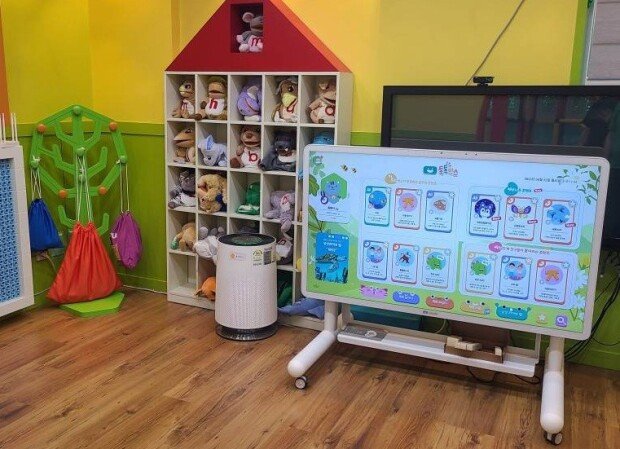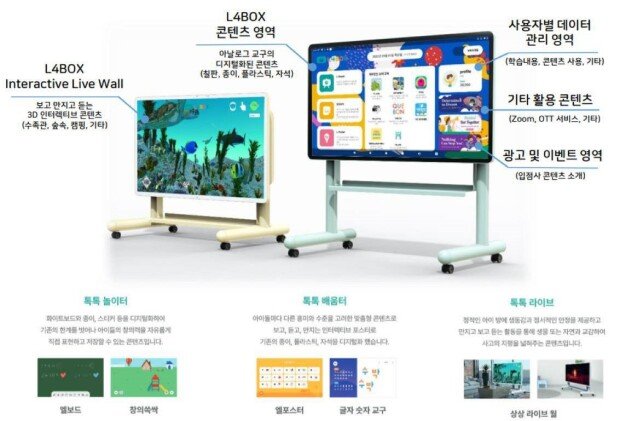L4BOX: "TokTok Box is More than just an Electronic Blackboard"
L4BOX: "TokTok Box is More than just an Electronic Blackboard"
Posted December. 26, 2024 10:42,
Updated December. 26, 2024 10:44
Currently, electronic blackboards are commonly used in schools and academies. These devices allow users to write with electronic pens instead of chalk, and can display various types of multimedia educational content. While some of their features cater to students (e.g., video conferencing), they are primarily designed for use by teachers and lecturers, with their usage patterns being shaped accordingly.
L4BOX, a smart learning startup, has developed the “TokTok Box,” an educational display tailored for children, especially preschoolers aged 5 to 7. The CEO of L4BOX, Hyun-woo Jang, emphasized that the TokTok Box should not be called an “electronic blackboard.” Instead, he describes it as a large-screen smartphone or a tablet PC. Here is an in-depth look at the TokTok Box from Hyun-woo Jang.
 Hyun-woo Jang, CEO of L4BOX (Source: IT DongA)
Hyun-woo Jang, CEO of L4BOX (Source: IT DongA)
Last year, IT DongA interviewed you when the TokTok Box had just begun to be supplied to national and public daycare centers and to kindergartens in Seoul. How has your business evolved over the past year?
Initially, the TokTok Box was aimed at individual households. However, the demand from institutions and corporate clients, including daycare centers, kindergartens, and kids’ cafes, has grown significantly. Once it’s been deployed in a daycare center or kindergarten within a region, the word-of-mouth among school principals has been driving additional sales. Consequently, we shifted our sales strategy in order to collaborate with regional educational tool distributors, establishing sales branches nationwide to supply the TokTok Box locally. This strategy has led to rapid results, with continuous product demonstration requests.
You emphasize that the "TokTok Box is not an electronic blackboard;" yet its appearance and usage patterns resemble one. What sets it apart?
Most consumers have reacted similarly, often asking, "Why is this electronic blackboard so expensive?" My response is, “the TokTok Box is the future of electronic blackboards.” The TokTok Box surpasses the basic functions of an electronic blackboard by focusing on self-directed educational content designed for young children and early elementary school students. It enables children to directly execute, experience, and learn the educational content through a large-display device. In other words, while electronic blackboards are teacher-centric, TokTok Box is child-centric.
The TokTok Box allows children to manipulate and engage with leading educational content from domestic and international providers, on a 55-inch touch display. All the preloaded educational content is free for one year after purchasing the product, transitioning to a subscription model afterward, with regular updates to introduce new content. Unlike TVs or electronic blackboards, it is tailored to a child’s eye level, with a low stand height and rounded corners to prevent accidents.
The feedback from principals and teachers has been overwhelmingly positive. Many appreciate using the 55-inch display to conveniently manage their schedules, announcements, and the reward charts within their institutions.
 TokTok Box deployed in a daycare center (Source: IT DongA)
TokTok Box deployed in a daycare center (Source: IT DongA)
Currently, you only supply the 55-inch display model. Why is that?
We believe that children’s smart devices should have larger screens. From a young age, children often use 5-10 inch smartphones or tablets, which is leading to issues like poor eyesight and posture problems. In addition, consuming content on small screens fosters isolation in children, hindering communication, social interactions, and emotional bonds. A 55-inch display is ideal for children aged 5-7 or early elementary school students to use while standing or sitting. It’s suitable for individual use, as well as group activities with peers, or for collaborative use with parents or teachers. The device is also designed to be safely moved around.
In the future, we are planning to introduce models with displays larger than 55 inches, to accommodate enhanced educational content for upper elementary school students.
 The TokTok Box is designed for use with parents, teachers, and friends (Source: IT DongA)
The TokTok Box is designed for use with parents, teachers, and friends (Source: IT DongA)
The world is facing an aging population crisis, with South Korea’s declining birthrate emerging as a serious social issue. This suggests a potential contraction in the early childhood education market. What are your thoughts on this issue?
Indeed, several educational content companies have ceased their operations due to this matter. We’re therefore analyzing the education market, while planning to expand our reach beyond early childhood education facilities to include special education schools for those with developmental disabilities, hotel/resort rooms with kids’ zones, regional kids’ cafes, and childcare cafes. While we cannot reverse the declining birthrate, we are aiming to broaden the scope of educational opportunities for the children who are born each year.
Do you see a positive potential for the TokTok Box in international early childhood education markets? Have you made any inroads into export sales?
Each country has different standards and perspectives on early childhood education, but the market has promising opportunities. In the United States, where many families live far from preschools or academies and have spacious homes, the TokTok Box is well-suited to be a digital or homeschooling tool. My conversations with the American attendees at educational tool demonstrations and exhibitions has confirmed its potential as a viable product for homes and educational institutions in the US.
We are also focusing on the Southeast Asian market. During our participation in the Vietnam Education Expo through SBA’s global expansion program in September, we received positive responses, while even winning an award at the expo. Our export discussions have since progressed, and we anticipate launching in Vietnam and other overseas markets next year. We have also received export proposals from KOTRA and are planning to participate in CES 2025 in the US, in order to promote our brand and products.
Large educational content companies could integrate their content into similar displays. How will L4BOX maintain its market competitiveness?
L4BOX specializes in educational content, while also possessing a display hardware technology. As a spin-off from LG Electronics, we are able to incorporate extensive display technology expertise into our products. Some large companies have introduced tablet-based educational tools, but these are neither optimized for specific educational content nor cost-effective relative to their utility. For these companies, collaborating with startups like ours is a practical way to enter this market. In fact, some of their educational content is already integrated into the TokTok Box. We hold numerous related patents and copyrights, along with an extensive library of educational content, which has enabled us to establish a foothold in the market more quickly than other startups.
Institutions like kindergartens or schools may find the price manageable, but a 5 million KRW TokTok Box could be prohibitively expensive for individual households.
Previously, in partnership with a credit card company, we offered a 24-month interest-free installment plan for individual households. With its built-in 4K UHD display and 55-inches of exclusive educational content, the TokTok Box also doubles as a TV. This means that consumers appreciated its value. The attached stand makes it portable, in a manner similar to popular portable monitors/displays like the LG StanbyME. Regular updates to our educational content and early elementary school curricula also extend its usability to over five years. Consequently, our household inquiries and purchases have gradually increased. Moreover, we’re planning future programs that will further reduce the cost for households.
How do you develop or source the educational content that’s integrated into the TokTok Box?
Currently, the TokTok Box includes over 60 types of educational content. Digital learning tools, such as electronic blackboards, reward sticker charts, learning posters, and voting tools, are being developed in-house. The language-related content in “TokTok School” is regularly updated through partnerships with language education companies like JungSang Academy. We are also exploring content designed for seniors, including features for cognitive health and dementia prevention. Our collaborations with companies that own popular children’s characters make expanding our content offerings straightforward.
 The TokTok Box’s primary educational content features (Source: L4BOX)
The TokTok Box’s primary educational content features (Source: L4BOX)
As a startup in a challenging industry, what are your biggest concerns or obstacles?
Manpower remains our biggest challenge. As our business continues to grow, we need dedicated personnel for marketing and consultations. In addition, since our displays are produced domestically, we are always looking for technical support and after-sales service staff.
How did your performance align with your 2024 sales goals, and what are your plans for next year?
Supply shortages have contributed to a strong performance this year. The positive response we’ve received from educational institutions, driven by content developed based on the feedback from teachers, has resulted in a 3-4 times greater achievement than in 2023. The content subscription model, which is activated after the first year, has maintained a low attrition rate. This means that our nationwide sales branch strategy has been effective. Next year, we are planning to deploy even more sales branches and aim to produce approximately 600 units of the TokTok Box. Following our successful pre-Series A funding this year, we’ll focus on scaling up our production in 2025.
By Moon-gyu Lee (munch@itdonga.com)
L4BOX, a smart learning startup, has developed the “TokTok Box,” an educational display tailored for children, especially preschoolers aged 5 to 7. The CEO of L4BOX, Hyun-woo Jang, emphasized that the TokTok Box should not be called an “electronic blackboard.” Instead, he describes it as a large-screen smartphone or a tablet PC. Here is an in-depth look at the TokTok Box from Hyun-woo Jang.

Last year, IT DongA interviewed you when the TokTok Box had just begun to be supplied to national and public daycare centers and to kindergartens in Seoul. How has your business evolved over the past year?
Initially, the TokTok Box was aimed at individual households. However, the demand from institutions and corporate clients, including daycare centers, kindergartens, and kids’ cafes, has grown significantly. Once it’s been deployed in a daycare center or kindergarten within a region, the word-of-mouth among school principals has been driving additional sales. Consequently, we shifted our sales strategy in order to collaborate with regional educational tool distributors, establishing sales branches nationwide to supply the TokTok Box locally. This strategy has led to rapid results, with continuous product demonstration requests.
You emphasize that the "TokTok Box is not an electronic blackboard;" yet its appearance and usage patterns resemble one. What sets it apart?
Most consumers have reacted similarly, often asking, "Why is this electronic blackboard so expensive?" My response is, “the TokTok Box is the future of electronic blackboards.” The TokTok Box surpasses the basic functions of an electronic blackboard by focusing on self-directed educational content designed for young children and early elementary school students. It enables children to directly execute, experience, and learn the educational content through a large-display device. In other words, while electronic blackboards are teacher-centric, TokTok Box is child-centric.
The TokTok Box allows children to manipulate and engage with leading educational content from domestic and international providers, on a 55-inch touch display. All the preloaded educational content is free for one year after purchasing the product, transitioning to a subscription model afterward, with regular updates to introduce new content. Unlike TVs or electronic blackboards, it is tailored to a child’s eye level, with a low stand height and rounded corners to prevent accidents.
The feedback from principals and teachers has been overwhelmingly positive. Many appreciate using the 55-inch display to conveniently manage their schedules, announcements, and the reward charts within their institutions.

Currently, you only supply the 55-inch display model. Why is that?
We believe that children’s smart devices should have larger screens. From a young age, children often use 5-10 inch smartphones or tablets, which is leading to issues like poor eyesight and posture problems. In addition, consuming content on small screens fosters isolation in children, hindering communication, social interactions, and emotional bonds. A 55-inch display is ideal for children aged 5-7 or early elementary school students to use while standing or sitting. It’s suitable for individual use, as well as group activities with peers, or for collaborative use with parents or teachers. The device is also designed to be safely moved around.
In the future, we are planning to introduce models with displays larger than 55 inches, to accommodate enhanced educational content for upper elementary school students.

The world is facing an aging population crisis, with South Korea’s declining birthrate emerging as a serious social issue. This suggests a potential contraction in the early childhood education market. What are your thoughts on this issue?
Indeed, several educational content companies have ceased their operations due to this matter. We’re therefore analyzing the education market, while planning to expand our reach beyond early childhood education facilities to include special education schools for those with developmental disabilities, hotel/resort rooms with kids’ zones, regional kids’ cafes, and childcare cafes. While we cannot reverse the declining birthrate, we are aiming to broaden the scope of educational opportunities for the children who are born each year.
Do you see a positive potential for the TokTok Box in international early childhood education markets? Have you made any inroads into export sales?
Each country has different standards and perspectives on early childhood education, but the market has promising opportunities. In the United States, where many families live far from preschools or academies and have spacious homes, the TokTok Box is well-suited to be a digital or homeschooling tool. My conversations with the American attendees at educational tool demonstrations and exhibitions has confirmed its potential as a viable product for homes and educational institutions in the US.
We are also focusing on the Southeast Asian market. During our participation in the Vietnam Education Expo through SBA’s global expansion program in September, we received positive responses, while even winning an award at the expo. Our export discussions have since progressed, and we anticipate launching in Vietnam and other overseas markets next year. We have also received export proposals from KOTRA and are planning to participate in CES 2025 in the US, in order to promote our brand and products.
Large educational content companies could integrate their content into similar displays. How will L4BOX maintain its market competitiveness?
L4BOX specializes in educational content, while also possessing a display hardware technology. As a spin-off from LG Electronics, we are able to incorporate extensive display technology expertise into our products. Some large companies have introduced tablet-based educational tools, but these are neither optimized for specific educational content nor cost-effective relative to their utility. For these companies, collaborating with startups like ours is a practical way to enter this market. In fact, some of their educational content is already integrated into the TokTok Box. We hold numerous related patents and copyrights, along with an extensive library of educational content, which has enabled us to establish a foothold in the market more quickly than other startups.
Institutions like kindergartens or schools may find the price manageable, but a 5 million KRW TokTok Box could be prohibitively expensive for individual households.
Previously, in partnership with a credit card company, we offered a 24-month interest-free installment plan for individual households. With its built-in 4K UHD display and 55-inches of exclusive educational content, the TokTok Box also doubles as a TV. This means that consumers appreciated its value. The attached stand makes it portable, in a manner similar to popular portable monitors/displays like the LG StanbyME. Regular updates to our educational content and early elementary school curricula also extend its usability to over five years. Consequently, our household inquiries and purchases have gradually increased. Moreover, we’re planning future programs that will further reduce the cost for households.
How do you develop or source the educational content that’s integrated into the TokTok Box?
Currently, the TokTok Box includes over 60 types of educational content. Digital learning tools, such as electronic blackboards, reward sticker charts, learning posters, and voting tools, are being developed in-house. The language-related content in “TokTok School” is regularly updated through partnerships with language education companies like JungSang Academy. We are also exploring content designed for seniors, including features for cognitive health and dementia prevention. Our collaborations with companies that own popular children’s characters make expanding our content offerings straightforward.

As a startup in a challenging industry, what are your biggest concerns or obstacles?
Manpower remains our biggest challenge. As our business continues to grow, we need dedicated personnel for marketing and consultations. In addition, since our displays are produced domestically, we are always looking for technical support and after-sales service staff.
How did your performance align with your 2024 sales goals, and what are your plans for next year?
Supply shortages have contributed to a strong performance this year. The positive response we’ve received from educational institutions, driven by content developed based on the feedback from teachers, has resulted in a 3-4 times greater achievement than in 2023. The content subscription model, which is activated after the first year, has maintained a low attrition rate. This means that our nationwide sales branch strategy has been effective. Next year, we are planning to deploy even more sales branches and aim to produce approximately 600 units of the TokTok Box. Following our successful pre-Series A funding this year, we’ll focus on scaling up our production in 2025.
By Moon-gyu Lee (munch@itdonga.com)







